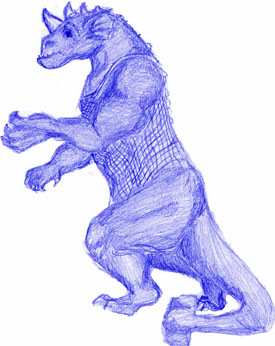On their warfare, family structure, and life-cycle.
Doom Pixie warfare is unique among all the peoples of the world. Because doom pixies are so small, for them to use the conventional tactics would be absurd. Instead, the have three major tactics they use in combat - Sabotage, Sorcery, and Sight-seizure.
The first tactic is sabotage. If the pixies have some grievance with a group of people, they will send warriors to break things, steal food, move objects from one side of a house to another, and cause general mischief. They are also fond of stealing one half of a pair of socks, and hiding all the writing utensils so you never have one when you need it. If this fails to get results, however, they move on the something a little more dangerous.
The next tactic is sorcery. This involves getting the most powerful of the Ojeki to get together and wreak havoc on the enemy, by summoning up a storm or some kind of monster under their control. This is sufficient to get all but the most stubborn enemies to back down.
If an enemy won't back down at this point, they'll generally decide to fight back by finding and attacking the pixie colonies. This is when pixies resort to their final tactic. If a mob is approaching a pixie colony, the Ojeki will make a general announcement giving the assailants one last chance to turn back. Then he lets out his cry of "Carpe Occulum!" and swarms of pixies will surround each member of the mob and gouge their eyes out with toothpick sized spears. The mob members often strike out in a blind rage and end up impaling each other. This is a deterrent to most mobs.
If it doesn't work, pixies consider themselves defeated and move on to form a new colony elsewhere. These migrations are very dangerous, and it can be years before a colony finds a new home.
In part one, the unusual family structure of the Doom pixies was alluded to, but I think it would be a good idea to elaborate somewhat. For the most part, Doom pixies do not mate for life. The dominant religion among the Doom pixies, in fact, encourages promiscuity, and since children are raised by the entire colony anyway, pregnancy is seldom a concern. Most Doom pixies, therefore, take part in a free love sort of philosophy, living alone or with close friends of either gender.
In recent years, however, Christianity has been growing among the pixies of many colonies. Christian pixies prefer to couple permanently, which authorities frown upon, but generally don't mind. More of a problem is the desire of some pixies to raise their own children exclusively.
In pixie culture, children are generally left to themselves to wonder the colony freely and discover the world for themselves. It is the responsibility of every pixie not only to care for the young and protect them from harm, but to take an interest in them and make them feel loved. On the rare occasion parents wish to raise their own children, they are seen with a mixture of scorn and pity. "Seperation anxiety" is seen as a disease of the mind, and such people must be kept away from babies until they get over it.
An interesting side-effect of this is Doom pixies names. Generally, as the colony gets to know a pixie child, a nickname sort of naturally emerges, based either on some physical trait, a personality trait, or something amusing that happened to them once. These names, like Eriswalneth (Triangular ears), Gunalae (Curios one) , or Tumtakolesthemwallock(kept trying to climb the walls until he broke his leg), generally stick with the child until the child grows his or her second set of wings. When a Doom pixie is able to fly (usually around 15 or 16 for girls, 17 or 18 for boys), he or she is considered an adult and allowed to choose a name which better describes them.
This is also the age where a young Doom pixies decides if he or she wants to be a sorceror or an artisan, in which case they are apprenticed, or just be a warrior/drone, in which case they go out into the wilderness with other young people and try to catch some local animal. The tradition varies based on what wild life is available, but the fundamentals are the same. Until the creature is caught and tamed, the group will be considered children. They will not be called by their chosen names, allowed to work in adult jobs, or do any adult things. They are also denied the priviledges of children. Because of this severe punishment, most groups return with a tame rodent of some sort, which is used as a hunting, herding or pack animal.
What you've just gotten is a basic overview of Doom pixie culture. It should be enough for you to better understand the stories which are to come.
Monday, September 27, 2004
Subscribe to:
Post Comments (Atom)

1 comment:
This rocks my socks! I heart the doom pixies.
Post a Comment